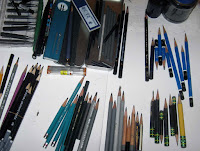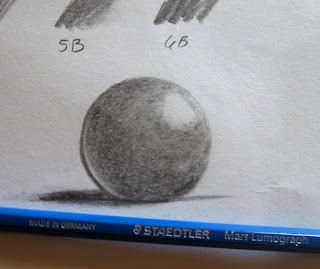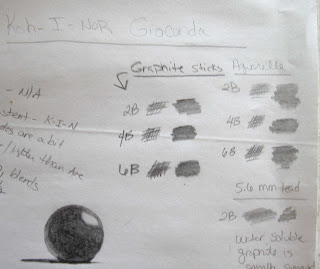 |
| My stash |
There are brands of luxury wood pencils sold in boxes of 12 for around twenty to thirty dollars, and those are the lower end of the luxury spectrum. Just look up Blackwing, Hi Uni, and Mitsubishi pencils some time, and you will see what I mean. They are not even marketed towards artists, which I would expect for that kind of dough. I have not tried these brands, but it's pretty tempting considering how much I love graphite. For now, I will just have to review the brands I have on hand: Staedtler, Prismacolor, Koh-I-Noor, Royal & Langnickel, Daler Rowney, Dixon Ticonderoga, Art Alternatives, and Portfolio Series by Crayola.
Today's post is covering Staedtler, Prismacolor, and Koh-I-Noor.
 |
| a little neater now! |
Affiliate Disclaimer: For full transparency, you should know that many of my links in my posts are affiliate links. As an Amazon affiliate, I receive a small commission when readers purchase items using my affiliate links. This helps me fund the blog domain costs, and you will not be charged extra if you buy anything using my links.
To date, my most extravagant graphite purchase has been a set of Staedtler Mars Lumograph
Why Lumograph pencils Rock:
- Smooth, velvety texture- blends beautifully
- Solid core rarely breaks, even on softer degrees
- High quality wood for casing (important for pencil's longevity)
- Very nice value range achieved with middle grades (HB, B, 2B) alone
- Degrees range from 8B (very soft) to 6H (rather hard)
Why Lumograph pencils Suck:
 |
| small pic of the swatches |
- They don't- the price is higher, but, again, I can see why.
I did some test drawings with swatches for this post to make a fair comparison between brands. I used smooth, lightweight sketch paper by Pacon that has qualities akin to newsprint. I used the crappy paper because I have found that most pencils can produce decent values on heavier textured papers, but cheap, nearly toothless paper reveals the flaws in the graphite's consistency.
The Lumograph pencils are easy to blend and yield consistent, predictable tones even on the inferior paper. The H degrees produce crisp, light lines without scratching into the paper, and they did not smudge. The B grades produced dark values with ease, and I did not need to use a stump to blend.
 |
Staedtler Mars Carbon Drafting Leads
I mentioned my trusty Alvin lead holder in my previous post about Stuff that Lasts, and since I use it almost daily, I don't think it is redundant to mention it again here. The 2 mm drafting leads that go in the lead holder are rather nice as well. I prefer HB and 2B, but you can get them in 7 degrees : 4B, 2B, HB, B, H, 2H, and 4H. You can buy them in packs of 3 or 12.
Unexpected Bonus: I use a rotary lead pointer , also from Staedtler, to sharpen my 2 mm leads. Most lead holders have an alleged "pointer" attached on the end cap. These are pretty awful because they make a crappy point and get powder everywhere. The rotary pointer creates a beautifully tapered point, and it has a tub to collect the graphite shavings. By "shavings" I mean extremely fine powder, which is very useful for certain effects in graphite artwork. You can accumulate a nice supply of graphite powder if you use this sharpener often. You will want to empty it frequently because a full tub makes a mess if you knock it over. Graphite stains in carpet are quite frustrating to clean.
, also from Staedtler, to sharpen my 2 mm leads. Most lead holders have an alleged "pointer" attached on the end cap. These are pretty awful because they make a crappy point and get powder everywhere. The rotary pointer creates a beautifully tapered point, and it has a tub to collect the graphite shavings. By "shavings" I mean extremely fine powder, which is very useful for certain effects in graphite artwork. You can accumulate a nice supply of graphite powder if you use this sharpener often. You will want to empty it frequently because a full tub makes a mess if you knock it over. Graphite stains in carpet are quite frustrating to clean.
Prismacolor Turquoise Drawing Pencils
I use a lot of Prismacolor products, in case you haven't noticed already, including their Turquoise, Scholar, Ebony, Premier Woodless Graphite, and Water Soluble Graphite pencils. I am not going to detail every line, but I will say that all of these pencils are of good quality, even the cheaper Scholar graphite pencils. Turquoise (also called Premier Turquoise) is the artist grade line, and I think these pencils are almost as nice as the Lumograph brand.
I say "almost" because I noticed inconsistencies in the Turquoise H degrees when I tested them on the cheap paper. The most striking oddity was that 6H was darker than 4H, and it should be lighter. I double-checked to make sure my pressure was consistent for both grades. I also noticed that the B grades are not as dark as I would like when used on smooth paper. There is little difference between the 6B and 2B in the Turquoise line. I used the woodless 6B and Premier Ebony pencils to add the darkest values to my test sketch. One caveat: When I made swatches with the Prismas on the rougher paper in my sketchbook, I was able to get a better range of values.
Even though the Prisma Turquoise pencils do not perform as well on slicker paper, the graphite quality is very good. You don't have to worry about grainy or streaky bits when laying down solid areas of tone or when making subtle gradients.
My Prismacolor Premier Graphite set included six Turquoise pencils, four woodless graphite pencils in HB and 2B, 4B, and 6B, and a few water soluble graphite pencils. I have used the woodless pencils to tiny nubs, so I had to guess the degree on two of them- the only one still labelled is the 6B. I rarely use the water soluble pencils. They are fine for dry sketching, but I cannot comment on their properties when used for washes.
Why Prismacolor Premier Turquoise Pencils Rock:
 The graphite sticks are rather nice, comparable to Staedtler and Prismacolor, but, again, the values are much lighter and they feel much harder when you draw with them. I layered the 6B heavily when I made the test sketch in order to keep the final values comparable to the Lumo and Prisma sketches. The graphite sticks blend nicely with no annoying streaks, crumbs, or scratchy bits.
The graphite sticks are rather nice, comparable to Staedtler and Prismacolor, but, again, the values are much lighter and they feel much harder when you draw with them. I layered the 6B heavily when I made the test sketch in order to keep the final values comparable to the Lumo and Prisma sketches. The graphite sticks blend nicely with no annoying streaks, crumbs, or scratchy bits.
I say "almost" because I noticed inconsistencies in the Turquoise H degrees when I tested them on the cheap paper. The most striking oddity was that 6H was darker than 4H, and it should be lighter. I double-checked to make sure my pressure was consistent for both grades. I also noticed that the B grades are not as dark as I would like when used on smooth paper. There is little difference between the 6B and 2B in the Turquoise line. I used the woodless 6B and Premier Ebony pencils to add the darkest values to my test sketch. One caveat: When I made swatches with the Prismas on the rougher paper in my sketchbook, I was able to get a better range of values.
Even though the Prisma Turquoise pencils do not perform as well on slicker paper, the graphite quality is very good. You don't have to worry about grainy or streaky bits when laying down solid areas of tone or when making subtle gradients.
 |
| I wish I had noticed the smudge before taking pics |
My Prismacolor Premier Graphite set included six Turquoise pencils, four woodless graphite pencils in HB and 2B, 4B, and 6B, and a few water soluble graphite pencils. I have used the woodless pencils to tiny nubs, so I had to guess the degree on two of them- the only one still labelled is the 6B. I rarely use the water soluble pencils. They are fine for dry sketching, but I cannot comment on their properties when used for washes.
Why Prismacolor Premier Turquoise Pencils Rock:
 |
| prisma swatches |
- Smooth, consistent graphite content
- Produce good value range on papers with at least a little bit of texture
- Blend nicely, probably won't need a stump or tortillion
- Good range of degrees from 9H to 9B (Ebony is very close to 9B in other brands)
- Price is more affordable than Lumograph
Why Prismacolor Premier Turquoise Pencils Suck:
- Smooth paper seems to inhibit Prisma value range dramatically
Prismacolor Premier Turquoise ( A.k.a "Eagle") drafting leads:
I have several packs of the Eagle leads in various degrees, but I really favor the 2B for sketching. I use Prisma 2 mm leads in my drafting pencil more often than I use the Staedtler Mars brand because I was able to get a bunch in a bulk listing at Etsy.com. They are supposedly "vintage", hence the older "Eagle" branding on the packages. Even so, the leads are strong and the graphite is excellent. You can buy new Premier Turquoise drafting pencils and 2 mm leads, which range from 9H to 6B. Drafters use the harder degrees more, which is why more H degrees are available than B.
Koh-I-Noor Gioconda Graphite Pencils, Sticks and Leads
As I have mentioned in other reviews, KIN products tend to be harder across the board, and I include graphite, charcoal, and their oil-based Negro artificial charcoal in this observation. I have a Gioconda drawing set that includes three graphite sticks and three water soluble graphite pencils, each in 2B,4B, and 6B. Again, I do not use graphite for washes, although I may try it soon. I also use some KIN 2B leads in my 5.6 mm clutch pencil and a very worn KIN (may be Cretacolor- both made in Austria) 9B woodless graphite pencil.
and a very worn KIN (may be Cretacolor- both made in Austria) 9B woodless graphite pencil.
After sketching with the dry water soluble pencils, I found the graphite to be a touch lighter than that in my leads and sticks, and it is slightly waxy- not crayon or candle waxy, but hard colored pencil waxy. The water soluble graphite renders smooth lines and shaded areas, and they work fine for lighter values in sketches and drawings. You don't need water to blend them.
 The graphite sticks are rather nice, comparable to Staedtler and Prismacolor, but, again, the values are much lighter and they feel much harder when you draw with them. I layered the 6B heavily when I made the test sketch in order to keep the final values comparable to the Lumo and Prisma sketches. The graphite sticks blend nicely with no annoying streaks, crumbs, or scratchy bits.
The graphite sticks are rather nice, comparable to Staedtler and Prismacolor, but, again, the values are much lighter and they feel much harder when you draw with them. I layered the 6B heavily when I made the test sketch in order to keep the final values comparable to the Lumo and Prisma sketches. The graphite sticks blend nicely with no annoying streaks, crumbs, or scratchy bits.
Why Koh-I-Noor Rocks:
- Good quality, consistent graphite content
- Blends well, rarely need a stump or tortillion
- Progresso Woodless graphite pencils available in HB through 9B (No Hs)
- Koh-I-Noor Professional Drawing Pencils available in 5H through 9B
- Koh-I-Noor Gioconda Graphite available in 2B. 4B, 6B (leads, Aquarelle, and sticks)
Why Koh-I-Noor Sucks:
- The sticks and leads only come in three degrees- yeah I have that in the "rocks" section because at least there are choices, but I would like more B grades in the leads and sticks.
- Kinda pricey (just "kinda" though)
- Confusing product names and descriptions- some are from Austria, some made in Czech, brand names seem to change, what is up with that? (see my post on charcoal brands for more info).
None of these brands really suck. I just wanted to do something different than the boring "pros" and "cons" headings I see everywhere. I think all three companies offer higher quality products on the whole, but they are also at the upper end of my raggedy artist budget.
Part II in the graphite series will cover cheaper brands and a few stragglers that I think are worth mentioning.

I agree the staedtler autographs are awesome .
ReplyDeleteI wanted to thank you for this excellent read!! I definitely loved every little bit of it. I have you bookmarked your site to check out the new stuff you post. electric pencil sharpeners
ReplyDelete